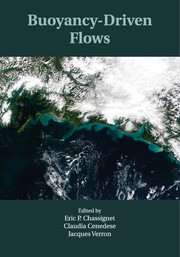Book contents
- Frontmatter
- Contents
- List of Contributors
- Introduction
- 1 Gravity currents – theory and laboratory experiments
- 2 Theory of oceanic buoyancy-driven flows
- 3 Buoyancy-forced circulation and downwelling in marginal seas
- 4 Buoyant coastal currents
- 5 Overflows and convectively driven flows
- 6 An ocean climate modeling perspective on buoyancy-driven flows
- 7 Buoyancy-driven currents in eddying ocean models
- 8 Atmospheric buoyancy-driven flows
- 9 Volcanic flows
- 10 Gravity flow on steep slope
- Index
- Plate section
- References
7 - Buoyancy-driven currents in eddying ocean models
Published online by Cambridge University Press: 05 April 2012
- Frontmatter
- Contents
- List of Contributors
- Introduction
- 1 Gravity currents – theory and laboratory experiments
- 2 Theory of oceanic buoyancy-driven flows
- 3 Buoyancy-forced circulation and downwelling in marginal seas
- 4 Buoyant coastal currents
- 5 Overflows and convectively driven flows
- 6 An ocean climate modeling perspective on buoyancy-driven flows
- 7 Buoyancy-driven currents in eddying ocean models
- 8 Atmospheric buoyancy-driven flows
- 9 Volcanic flows
- 10 Gravity flow on steep slope
- Index
- Plate section
- References
Summary
Introduction
Dynamics of Water Mass Formation and Spreading
Small-scale buoyancy-driven flows, such as the overflows from marginal seas, are the main process by which the distinct water masses of the deep ocean are formed. For example, the flow of Antarctic Bottom Water (AABW) from the continental shelf down to the bottom of the Weddell Sea influences water mass properties all the way to the North Atlantic Ocean. The large range of spatial scales and mechanisms involved in the formation and spreading of these water masses poses a formidable challenge to numerical models. Legg (Chapter 5, this volume) reviews the main dense overflows of the world ocean. The width of an overflow is set either by the width of the strait or channel through which it flows (in the case of the Red Sea overflow, for example) or by the Rossby radius of deformation, which is the main dynamic scale for stratified rotating fluids. For an overflow of thickness h, with density anomaly δρ relative to the density ρ of the surrounding fluid, the reduced gravity g′ is defined as gδρ/ρ (g being the acceleration of gravity) and the Rossby radius Lr is defined as Lr = (g′h)1/2 /f with f being the Coriolis parameter. Lr decreases with latitude and its magnitude is only a few kilometers in the Nordic Seas. The dynamics of the plumes of dense water and the amount of entrainment that takes place as they descend along topographic slopes set the properties of the newly formed water masses (e.g., Chapter 5 by Legg).
- Type
- Chapter
- Information
- Buoyancy-Driven Flows , pp. 281 - 311Publisher: Cambridge University PressPrint publication year: 2012
References
- 3
- Cited by

